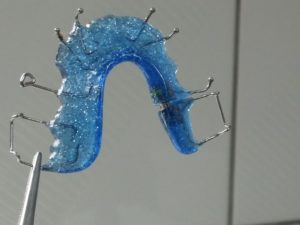
All of my kids started their orthodontic treatment in early elementary school. Two of the three were already in braces by first grade, and all three had already had their phase one of treatment started, primarily the palatal expander, done before they hit double digits.
I didn’t know at the time that the American Association of Orthodontics recommends that kids get their first orthodontic check up at the first sign of an orthodontic problem, but no later than age 7. By then, kids have enough permanent teeth for the doctor to determine if a problem exists, or is already developing. I just knew we had a problem, and the pediatric dentist wasn’t fixing it.
I knew my oldest had an emerging problem when the dentist had to cut a slit in my son’s gum for the permanent tooth to finally drop. We had been waiting on it far longer than it should’ve taken, and by that time, the other kids at school were in full bullying mode over his mouth. He needed the palatal expander to make room for all the teeth that needed to come in, and shape the palate into a workable shape for the jaw to develop properly. Basically, palatal expanders create more space in a child’s mouth by gradually widening the upper jaw. A major benefit of starting orthodontic treatment in childhood is that it’s possible to take full advantage of a child’s own natural growth process to treat, or even prevent, bad bites. And as a side note, you will be far more horrified than your kid is each day when you have to “turn the key” to expand the appliance further and further. All three of my boys had a palate expander and lived to tell about it.
My youngest, around first grade, had a bottom, permanent tooth growing in at such an angle out into his lip, that even a bite of an apple could’ve dislodged that tooth from the bone. The pediatric dentist didn’t worry nearly as much as we thought he should, but the orthodontist had brackets around that tooth within a week to save both the tooth and his bone.
My middle son, bless him, had the most normal mouth of the three. He had the palatal expander early, but was then parked in a holding pattern for further treatment until he lost more baby teeth. This was his Phase 1 of treatment.
So basically, in our experience anyway, there will be a Phase 1 of treatment. Maybe an aggressive treatment of early braces as with my youngest and oldest, maybe just the expander to form the jaw as it grows. We had a fee for the Phase 1 treatment for each kid based on the prescribed treatment, not based on length of treatment. As far as payment went, the Phase 1 covered all orthodontist visits, and all work until the work of Phase 1 was complete. Then they graduate to Phase 2, with an all new treatment plan and fee, and not any certain age. Then finally, they get to the retainer time…. and good luck convincing your teenager that his teeth will go right back from whence they came if he doesn’t wear it.
My youngest who had braces in first grade in Phase 1, kept them on for about a year at that time, then had them removed and was placed in his own holding pattern of growth until he was ready for Phase 2. He started Phase 2 in 6th grade, getting braces on for the second time, and will have them off before the end of his 8th grade year. However, my oldest went seamlessly from Phase 1 into his Phase 2 with his braces staying on the entire time, maybe about 5 years. Kid 2 went pretty much the traditional route because of his good genes and incredible luck, and got his Phase 2 braces on in middle school and has been out of them to enjoy high school with a great smile.
And I’ll just tell you that it’s more expensive than you even want to think about right now. But we’re happy that we went with an orthodontist that believes in early treatment. It saved us in expense and grief in the end, especially considering the jaw and bone structure issues. Those are things that had we waited till all the baby teeth were out and the jaw had already grown and formed, that could’ve only been corrected with surgery. Starting them at such an early age allowed the doctor to correct some issues that could’ve gotten tons worse over time.
I like how the boys check in on a computer at their orthodontist when they arrive for an appointment. And their check-in picture is the latest picture of them taken at the beginning of their Phase 1 or Phase 2. If I ever doubted the value of investing in these boys’ smiles, each look at the before and after reminds me that we did the right thing.
I know there are still plenty of old school orthodontists around that want to wait till the teen years and throw some braces on for the crooked teeth, but I know that never would have corrected the issues my boys had. In hindsight, I’m glad we had some early teeth emergencies in our bunch to direct us toward the best care for our kids.














Hey Kristi!! You couldn’t be more spot on with early intervention. You’ve shared some great tips and personal experience here that I’m sure so many moms can learn from and ideally help their children. As a dentist and a mom to 4 kiddos myself, I thought I’d jump in on the convo to provide some additional things for moms to think about when considering when and how to address ortho treatment.
1- Research supports early evaluation for head and neck growth and development as early as 2 years old. There are a number of oral habits that start at a very early age that can drastically alter how a child’s jaw, tongue, airway, and teeth grow and develop. By evaluating a child early, a dentist trained in this type of therapy can help educate a parent on what habits to change (and when and how), what habits we aren’t concerned with. For example, prolonged thumb sucking or mouth breathing during the night time causes improper balance of bone and tissue and can lead to jaws that are misaligned, TMJs that pop or crack, and an airway that is narrow and can lead to other systemic inflammatory processes.
In addition to eliminating bad habits that can alter growth and development, the relationship of the upper and lower jaws as well as the size of baby teeth has been shown to predict at a 97% accuracy level how the adult teeth will erupt and how the jaws will come together.
In many practices, the “wait and see” mentality has been the norm, and its what many in our generation knew to be true when we were kids. But technology and research has allowed for advanced diagnostic tools such that we can catch problems early when they are relatively small, and then very well promote ideal development from there.
Another way to look at it or how I sometimes explain it to parents of my patients, if your child has scoliosis, does it make sense to you to wait until they are nearly finished growing, are in puberty, have their spine even more crooked than when you first noticed before you would put a back brace on to help straighten the spine back out? Of course that doesn’t make sense! So why do so many people think that’s a good idea for teeth? (if i could insert an emoji here, I would use the face palm one 😉 (this also relates to another topic about extracting adult teeth because there is insufficient room, but suffice it to say that this can absolutely be avoided in almost all cases, and I absolutely would recommend you get a second opinion if that is part of the treatment plan)
2 – Consider alternatives to braces. There are a host of different removable oral appliance therapies that do not require traditional, fixed braces. Not only does research support these approaches, but both my patients and I prefer them because they are more comfortable and they are vastly more hygienic. Instead of applying stainless steel forces to push and stretch the bone and tissue and making it so difficult to keep your teeth clean and cavity-free, I use soft, removable appliances that use the natural forces of the children’s muscles to promote proper dental eruption and jaw development. And by having it be removable, the child is able to keep his or her teeth much cleaner and healthier through the course of treatment.
3 – Teeth are easy; make sure you’re addressing the airway and jaw joints. People may or may not be aware that the rise in jaw joint pain (or TMJ pain as many know it by) and sleep apnea or snoring in the last couple of decades could have been avoided had these adults been treated as children for insufficient airway development and improper jaw development or relation. Our society has prioritized straight teeth and the esthetics, but to be honest, that is the easiest part of treating a patients mouth. What is more difficult (and therefore often not addressed) is how the airway is developing in relation to the head and neck and how the jaw joints come together. For many of these adults, they have teeth that are straightened into a position that lock their jaws and their away into a less than ideal, unhealthy position. Thus, they have these chronic conditions that lead to other chronic symptoms. However, if the jaw and airway are in the correct position and the appropriate size, then this healthy state can be stabilized (or “locked in”) by the position of the teeth. So I highly encourage any mom to inquire about the airway, inquire about the jaw. If it doesn’t make sense to you, trust your mom instinct and get a second opinion.
4 – Medical insurance can be used to cover ortho treatment. Now I typically don’t discuss cost when talking about the merits of a clinical decision or not, but I know that this type of treatment is a big decision for most families as they are choosing how and when to invest in their child’s oral health. At my practice, we recognized that we really could help a lot more patients by collaborating with physicians. We co-diagnose and co-prescribe all within our office, which allows us to help many of our patients receive coverage from both their dental and medical insurances. Now, I don’t think there are a lot of offices out there that do this, but I’d definitely encourage moms to ask. I’m aware of the difficulty when you’re choosing between braces this year or next vs that club baseball team payment or something else. Kids are expensive! So saving where you can really helps.
Lastly, I agree that bringing kids in at 7 is great, and i know that seems shockingly early to many who have grown up in the age of “wait until all their permanent teeth come in and then go see an orthodontist.” However, I advise the pediatricians I collaborate with to refer patients to our practice for initial evaluation as young as 18 months to 2 years old. Depending on the age, sometimes the appointment is short and all we do is look at big picture things, discuss habits and potential changes, and educate the moms. But sometimes, we are able to see something that will only get worse with time, and we are able to advise mom on when and how we would recommend doing something sooner while it’s easier to address.
Anyhoo, again, thank you Kristi for this great information!! For anyone who has questions, I’m a big proponent of the “it takes a village”, and I’m happy to help you and your kids, whether that means you’d like to come see my team and me or even if it means just answering questions or concerns you have about your current plan. Trust me. I am famous for giving soccer field sideline consults 😉 So I’m happy to help a fellow mom where and when I can.
Here’s to helping our kiddos reach their fullest potential!
Dr. Jill Ombrello
Oh my world full of good info! Thank you for adding such helpful info for moms just starting out on the orthodontic journey. My youngest gets his braces off in 2 weeks, ending what has been a 7 year process for him. And like I said in the post, had we not been forced into our first ortho situation out of emergency, we would’ve never been the wiser. I can totally see how starting my kiddos even earlier would’ve prevented even some of the issues we faced as late as the first grade. But we were on the traditional pediatric dentist path, with a wait and see doctor that we loved. I think that’s more the norm than the exception, still. But little by little we can get the word out that sooner is better than later as far as this subject goes. Thank you Dr. Ombrello for so much added here for us.